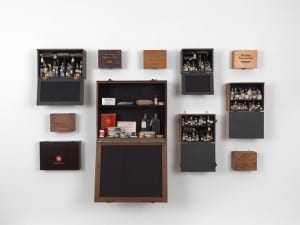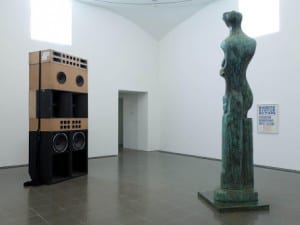Six practices, wildly diverse in culture, generation and medium, are united in their subject: our varying perceptions and measurements of time in the exhibition About Time, currently showing at Maddox Arts until 31 May.
About Time is, as curator Laura Culpan explains, a collaboration between gallery director Mario Palencia and herself; featuring British artists Troika, United Visual Artists and Royal Academician Paul Huxley (RA), US-based Bill Viola and South American Glenda León and Miler Lagos, the show combines Palencia’s favour for Latin American art with Culpan’s European links.
The resulting composition is a stream of lively contrasts, organised around a central piece by Cuban artist Glenda León: Wasted Time, a poetic ready-made meets sculpture. This is the decompression point of the show – the moment at which you are invited to slow your pace and consider.
Culpan began the curatorial process with this piece, explaining that “when a work speaks to you so profoundly from a still on the internet, before seeing the actual work in itself, that’s something quite remarkable,” and notes that it became the point of inspiration for the theme of the show. An antiquated hourglass, wedged into a mound of dusty sand that precariously balances atop a white plinth, the piece points at lost time – as if each turn of the glass has let some sand, some time, slip out and away.
Whilst Leon’s artwork is perhaps a pessimistic and fearful anticipation of time running out, her contemporary Miler Lagos instead considers the marks left by passed time: two tight collages of The Times newspaper emulate the growth rings of a tree, and act as drawings of his third piece – a sculptural stack of papers coiled into a forlorn looking tree stump.
Of course there is a play upon production (wood, paper, wood) and the construction process of the work is undoubtedly lengthy, yet in curling papers depicting recent news and financial stats into organic forms, the prevailing message is the differing significance of time depending upon individual and situation.
Another discussion is that of analogue versus digital, with Paul Huxley’s iconic 1970s painting, Metronome, Troika’s dice ‘drawings’, and United Visual Artist’s installation, Always /Never, which uses mathematic formulae and LED lights to emulate the sine wave naturally created by the sun over the course of a year.
A wall-mounted panel of triangular white metal frames, lit in a constantly changing myriad of pale violet, amber and dusky blue tones, UVA’s piece is a radiating, seductive glow which draws you into the back corner of Maddox Arts. Imitating nature through geometry and complex algorithms, Always/Never “examines the passing of time through the colour of daylight” and reminds of cold marble sundials, dramatic shadows cast by Egyptian pyramids, and even the overhead views of snow-topped mountains that can sometimes be glimpsed through aeroplane windows.
UVA’s seven-strong group was formed in 2003 by Matthew Clark, Chris Bird and Ash Nehru, and exhibiting at Maddox Arts, Barbican and at Eastbourne’s Towner Museum from 18 April, they are a prime example of a successful collective – perhaps due to their working methods which, as they explain below, are “fairly unique.”
A: UVA is a fairly extensive team; is each piece entirely collaborative? How do you tackle issues of ownership?
UVA: Every member of UVA is actively involved in the creation process, and each has a different background and an individual skill set. The complexity and scale of some of our projects means that we may all be involved, or sometimes there may just be two or three people working on a project. Either way the process is generally iterative. Our three founders decided from the beginning that UVA would have group authorship of our work. It’s a bit of a utopian vision but it seems to work.
A: Your work often concerns natural light rhythms, time and technology, why this fascination?
UVA: We’re interested in creating systems that allow us to synthesise phenomena seen in nature, often observed through the lens of science. Technology offers us the ability to create these systems and in turn explore the tension between synthetic and natural behaviour. Our fascination lies with the moment the barrier between what can be described as artificial and what is considered natural becomes less defined.
A: Always/Never has previously been exhibited in a group show about light; what do you think is the effect of re-framing it as a piece about time?
UVA: Always/Never is a work which examines the passing of time through the medium of light, so you could say the work is relevant in both scenarios. Time however, has a far more poetic connotation. Even though our medium is the colour of daylight, the piece itself is about your perception of time.
A: How do you think Always/Never converses with the rest of the show, and can you highlight and works which you think it reacts to most significantly?
UVA: With this show Laura Culpan has curated a diverse mix of mediums, and established and emerging art practices like ourselves, and this was one of the reasons we wanted to be involved. It’s great to see the different approaches come together and create something larger than the sum of its parts.
About Time, until 31 May, Maddox Arts, 52 Brook’s Mews, London W1K 4ED. For more information visit www.maddoxarts.com.
Words; Chloe Hodge
Credits
1. Image courtesy of United Visual Artist and Maddox Arts.





